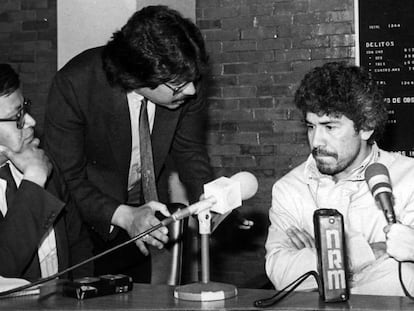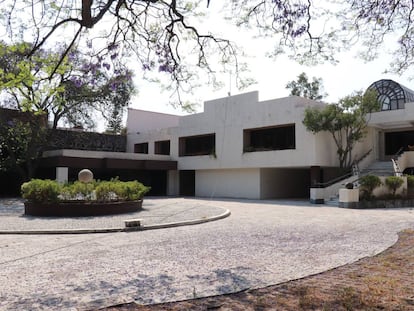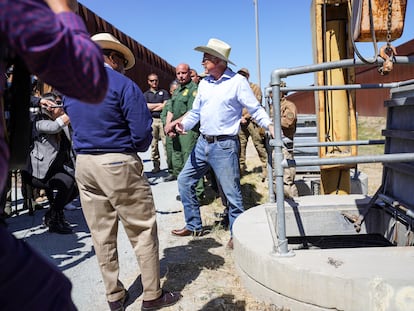Caro Quintero, the old drug lord who revolutionized the world of marijuana
At 69, he had been in operation longer than any other drug trafficker - until his arrest on Friday. He was already a millionaire by 30 thanks to his ability to mass produce a variety of seedless marijuana, favored by consumers and requiring less space to conceal

“Why are you smiling so much? Has life treated you well?”
“Yes, it has treated me well because I am alive.”
This was Rafael Caro Quintero’s response to a journalist in 1985 on the day he was sent to prison for the first time. He had just been caught with his girlfriend in Costa Rica, he was 33 years old and was the biggest marijuana dealer in the world. Last Friday, he was arrested again, this time in Sinaloa, some 93 miles from the town where he was born, and from where he led a small army that spreads terror in the northern Sonora region. In the world of drug lords, reaching the age of 33 is a blessing, but to make it to 69 is an extraordinary privilege, rewarded with a retirement of total liberty. However, Caro Quintero responded to this freedom in the same way as the fable of the scorpion and the turtle: he returned to drug trafficking.
Born in 1952 in the small city of Badiraguato, Sinaloa (in the north of Mexico), home to other notorious drug traffickers such as Joaquin El Chapo Guzman and Ernesto Fonseca, Don Neto, his life experience combined business know-how, love and violence in equal parts, qualities that drove him to the top of the drug trafficking industry in record time. Indeed, among the great drug lords of the 1980s, Caro Quintero is a classic example.
He was the son of a peasant couple who had 10 children, nephew of Lamberto Quintero and cousin of Amado Carrillo Fuentes (known as The Lord of the Skies, owing to his ability to bring small planes into the United States), Caro Quintero barely knew how to read and write when he started out, but his business intuition made him rich through marijuana in just a few years. Before turning 30, he had constructed the largest drug operation production center ever seen, some 1482 acres, and he had paid off police, military, politicians and judges across the country. Caro Quintero revolutionized the world of marijuana when he managed to mass produce seedless female plants which also took up less space. 4,000 employees worked on his farm in El Búfalo and truckloads of marijuana left it each day, the result of a sophisticated irrigation system and the construction of the first greenhouses in the whole of Mexico. Caro Quintero’s marijuana was not only the consumers’ first choice, but his production was also the biggest, bringing in more trucks and planes to the United States than any other supplier.

At that time, El Chapo Guzmán was only a hitman for the cartel that Caro Quintero led together with Don Neto and Félix Gallardo. One of them produced weed on scale, another introduced Colombian cocaine, and the third oversaw strategies to move trucks and planes into the United States. Together they made up the Guadalajara cartel, which later became the Sinaloa cartel, the most powerful in the country until a few years ago, with the emergence of Jalisco Nueva Generación.
One day in November 1984, hundreds of soldiers showed up at the farm, arrested all the workers and burned the 8,000 tons of marijuana they found. This was the largest single seizure of drugs in history. The evidence - an aerial photo of the huge camp - forced Mexico to act, under pressure from the United States.
After the coup, Caro Quintero swore revenge and three months later killed both Kiki Camarena Salazar, a DEA agent who had managed to infiltrate the farm, and the pilot of the plane. But he didn’t do it swiftly: he tortured them for weeks while a doctor kept them alive so that the boss could prolong the torment. The DEA has since sworn revenge.
Those were the times when drug traffickers frequented bars, flaunted their money in nightclubs, closed pick-up joints and were photographed with ministers and governors, where they appeared as successful businessmen from the countryside.
In one of the bars, the handsome and charming Caro Quintero, who had just finished elementary school, met Sara Cosío Vidaurri, a 17-year-old from conservative high society in Guadalajara, niece of the former Governor of Jalisco, Guillermo Cosío Vidaurri. With the DEA hot on his heels, he fled with her to Costa Rica. The family denounced her kidnapping and the saga of her escape was followed both in gossip magazines and in the news. The day the young woman called her parents to say that she was safe, the call was intercepted. When the police entered the house of the Bonnie and Clyde couple of Sinaloa, she told them: “I’m not kidnapped, I’m in love,” contemporary reports reveal.
After spending 28 years in five different prisons, Caro Quintero was freed in 2013 due to a legal loophole. A judge decided that he should not have been tried in a federal court, but in local one in his hometown, and released him just long enough for him to escape. Thus, at the age 59, the old drug lord got his freedom and he returned to his clandestine lifestyle.
In the images broadcast that day, there was nothing left of the confident and sarcastic young man who relished television interviews. Instead, he appeared as an old man who had decided to abandon the criminal life. However, this was all show, and he went straight back to his old ways in places such as Caborca or San Luis Río Colorado where he reassembled a small army and tried to make his way back into the world of organized crime.
When he was captured last Friday afternoon, army officials said he was hiding in some bushes and that a dog from the force found him. In the images, he appears to all intents and purposes as a well-dressed man wearing a jacket and an ironed shirt. Forty years after the murder of Kiki Camarena, the DEA kept Quintero as its number one target on the list of most wanted criminals and offered $20 million for his capture.
Criticized by the United States for his inaction in the face of violence, the president of Mexico, Andrés Manuel López Obrador, settled accounts with the past and can boast his first significant criminal catch with Caro Quintero’s arrest. However, his critics argue that this only occurred because Obrador had met with Biden at the White House three days prior. The United States, though, celebrates this as an account settled at long last.
Translated by Xanthe Holloway.
Tu suscripción se está usando en otro dispositivo
¿Quieres añadir otro usuario a tu suscripción?
Si continúas leyendo en este dispositivo, no se podrá leer en el otro.
FlechaTu suscripción se está usando en otro dispositivo y solo puedes acceder a EL PAÍS desde un dispositivo a la vez.
Si quieres compartir tu cuenta, cambia tu suscripción a la modalidad Premium, así podrás añadir otro usuario. Cada uno accederá con su propia cuenta de email, lo que os permitirá personalizar vuestra experiencia en EL PAÍS.
¿Tienes una suscripción de empresa? Accede aquí para contratar más cuentas.
En el caso de no saber quién está usando tu cuenta, te recomendamos cambiar tu contraseña aquí.
Si decides continuar compartiendo tu cuenta, este mensaje se mostrará en tu dispositivo y en el de la otra persona que está usando tu cuenta de forma indefinida, afectando a tu experiencia de lectura. Puedes consultar aquí los términos y condiciones de la suscripción digital.
More information
Últimas noticias
Most viewed
- Oona Chaplin: ‘I told James Cameron that I was living in a treehouse and starting a permaculture project with a friend’
- Sinaloa Cartel war is taking its toll on Los Chapitos
- Reinhard Genzel, Nobel laureate in physics: ‘One-minute videos will never give you the truth’
- Why the price of coffee has skyrocketed: from Brazilian plantations to specialty coffee houses
- Silver prices are going crazy: This is what’s fueling the rally











































